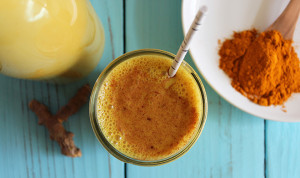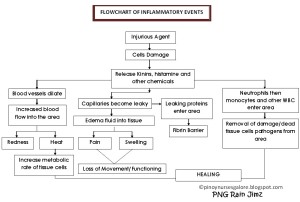As a Chiropractor, I have been interested in and following the research on inflammation. In the last few years there have been a number of studies suggesting that chronic inflammation lies at the root cause of many health issues.
We all need a small amount of inflammation in our bodies to maintain good health. For instance when you first injure yourself, the injury triggers a chain of events called the inflammatory cascade.
The familiar signs of normal inflammation are:
- Heat
- Pain
- Redness
- Swelling
These are the first signals that your immune system is being called into action. It is responding to repair any resulting damage. When our bodies are working smoothly and properly pro-inflammatory hormones in your body call out for your white blood cells to come and clear the damaged tissue. These agents are matched by equally powerful, closely related anti-inflammatory compounds, which move in once the threat is naturalized to begin the healing process.
This is a normal acute inflammatory response. Its ebbs and flows as needed and signifies a well balanced immune system.
Symptoms of Inflammation that don’t settle are telling you that the “ON” switch to your immune system is stuck. The body’s pro-inflammatory immune cells continue to be stimulated, and then chronic inflammation arises. So what started as a healthy mechanism, like building scar tissue or swelling, just won’t shut off.
What does low grade chronic Inflammation look like:
- skin outbreaks
- diarrhoea
- shortness of breath
- body aches and pains
- weight gain
- swelling
- stiffness
- congestion
- frequent infections
- fuzzy thinking
When you come to the Chiropractor with pain, we work to determine the cause and aim to restore proper motion of joints and posture. This will provide the best environment for healing after an injury.
However if chronic inflammation is at work in your body, it will cause an excess of immune cells to continually circulate in your system and can be damaging healthy areas such as joint tissue (which could lead to arthritis) It creates a harder base to work with and may slow the healing time of any new injury. So if you think chronic inflammation is playing a part in the background of your body, here is how you can help:
Tips to decrease inflammation:
Chronic inflammation stems from many sources, including hallmarks of the modern “busy†lifestyle.
- Stress Management – Chronic stress, broadly defined, is a link between hormones and inflammation, because stress, whether it’s psychological or physiologic, triggers the release of cortisol. Cortisol helps to mobilize blood sugar so that you can run effectively and efficiently from that tiger chasing you. It also acts as a systemic immune suppressant, lowering levels of secretory IgA, an important body guard of the gut mucosa.
- Exercise– Burst exercise is one recommendation. It is the most bang for your buck in terms of cardiovascular benefit and specifically enhancing mitochondrial health because it puts a special kind of stress on the body when you move to your max for 30 seconds that then recover for 90. I recommend 8 intervals 1-3x/week. Yoga and Pilates are also beneficial exercises for the management of stress and spinal function. Please talk to your chiropractor about what type of exercise would be suitable for you and your current situation.
- Meditation– The effects of stimulating the relaxation nervous system, even through listening to a 20 minute guided meditation, can be far-reaching. Enhanced genomic expression of anti-inflammatory genes and suppression of inflammatory ones has been demonstrated in many studies.
Consider the food you are eating
- common inflammatory foods are
- dairy
- gluten
- sugar
- alcohol
- corn
- soy
An elimination diet is an effective way to know if any of these foods are stimulating inflammation in your body. Completely eliminating a food for at least seven days, ( 14 days is better) and simply seeing whether symptoms improve or worsen when the food is re-introduced, will tell you whether you have an intolerance to this food.
Eat more foods that reduce inflammation:
- Good oils: olive, grape seed and avocado
- fish
- nuts
- fruits
- garlic, fresh herbs (particularly turmeric and green tea)
Turmeric Latte: How to do it?
As its winter I thought I would give you a recipe that I am using daily as my anti-inflammatory delight. Make it part of your morning instead of coffee. It’s quick and easy to make, save for an upfront 10 minute prep of turmeric paste.
Combine 1 cup of water with 1/2 a cup of organic turmeric in a saucepan and heat on low for about 7 minutes, adding more water (up to 1 additional cup) if it becomes too dry.
Remove from heat and stir in 1/3 cup of unrefined organic coconut oil or extra virgin olive oil, and 1/2-1 tsp of black pepper.
Store this in a glass container in the fridge.
In the morning, put one teaspoon of paste in a mug, add a dash of cinnamon, cardamom, clove, a teaspoon or two of raw honey to about a 1/3 cup of almond/coconut/hemp milk (look for unsweetened varieties, if you don’t want to make your own!). Fill the rest of the mug with boiling water
I also use the Paste in a smoothie if I am making one.
ENJOY!!!



